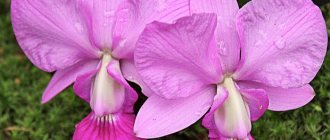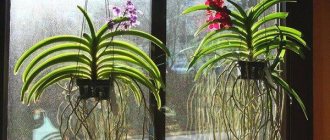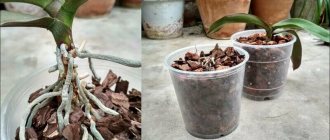Lush and long-lasting flowering depends on the living conditions in the apartment. They should be as close as possible to natural for this type of orchid. The frequency and duration of flowering depend on the variety and age of the orchid, lighting, humidity, and temperature. The article provides information about the periods and methods of stimulation, and describes the characteristics of the flowering of Phalaenopsis and Cattleya. It is described how to create favorable conditions during flowering and during the dormant period. The pros and cons of pruning the flower stalk are presented. The reasons for the withering and dropping of buds and flowers are indicated.
Frequency and duration
An orchid first blooms at 2-4 years of age, seedlings at 4-5 years. The number of formed leaves for the release of a peduncle is 5-8 pieces. The time during which an orchid blooms depends on the plant variety, growing conditions and care.
Usually the plant blooms once a year, for a period from several weeks to 3, 5, sometimes 8 months . Under natural conditions, flowering occurs during the dry summer season. In the northern hemisphere, this period corresponds to winter. In the natural environment, when the plant has flowered, the wind carries the seeds over a distance of several kilometers.
One peduncle, if not cut off, may bloom again. During this period, the orchid is intensively watered and fertilizing is used: succinic acid, vitamins in capsules, store-bought and home-prepared fertilizers.
An orchid at home is capable of flowering until it reaches the age of 10 years. Some varieties stop blooming after reaching 3 years. With improper care, the period is reduced, but under optimal, close to natural conditions, it increases. One flower blooms for 3-4 weeks. Full disclosure occurs within 24 hours.
Flowering period depending on the type of orchid:
- Cymbidium . October – February (in some sources – March), or from March to September. The peduncle is tied to supports, watering is reduced, and fertilizers are eliminated. Favorable temperature: 16-180C.
- Miltonia ("Butterfly Wings", "Pansies"), Miltassia . They bloom from March to June. Duration is 5-6 weeks. The temperature during the flowering period should be 18-220C.
- Dendrobium , Cymbidium . They bloom from early October to January (in some sources until the end of winter), sometimes in summer. Flowers - white, white-pink, crimson, lilac with a yellow center, lilac. To stimulate flowering, place the plant in a bright, cool place and stop watering.
- Oncidium blooms from April to July. Sometimes again - at the end of autumn, with a frequency of 1 time every 8-12 months. It may happen more often as the shoots develop.
- Paphiopedilum (“Slippers”, “Venus’s slipper”). The flowering period is from October to March. The rest period is not expressed. Good lighting and sufficient watering are provided throughout the year. In nature, this species is adapted to a lack of light (at the same time, Paphiopedilums are not shade-loving!) and high soil moisture.
- Odontoglossum . Flowering - late winter - early summer, for 2-3 months.
- Zygopetalum blooms from November to February, once or twice a year. Flowers in shades of green, brown, white and purple with spots and streaks.
Other conditions on which the period and duration of flowering depend:
- lighting,
- humidity,
- temperature.
The plant is replanted every two to three years. Signals for transplantation :
- Aerial roots have little space in the flowerpot and are located very close to each other. Perhaps they began to rot (due to too much compaction of the soil).
- Leaves, buds, and flowers turn yellow and wither. Occurs due to insufficient nutrition of the orchid through the roots on a dense substrate.
- Insects in the soil. The plant is taken out of the pot, the roots are washed in warm water, the pot and soil are changed.
- Viral, bacterial, fungal diseases. The roots are washed, the diseased parts are cut off, the sections are sprinkled with charcoal, cinnamon, and treated with hydrogen peroxide. The flowerpot and soil are changed.
After this, the orchid needs time to adapt, which takes up to 3 years. During this period the plant does not bloom.
Phalaenopsis
Flowering duration is from 2 to 8 months , beginning in December (in some sources - in January). Blooms up to three times during the year. 2-40 inflorescences of snow-white, dark scarlet, yellow and red shades are formed. Sometimes the color is blue. Flowers last up to 4 months.
Long flowering does not always have a positive effect on Phalaenopsis. Young and old plants that bloom for more than 3 months will use up all their strength, which will lead to the death of the orchid. The same applies to recently recovered and transplanted plants.
So, in order to interrupt unwanted prolonged flowering, the peduncle is carefully trimmed. The cut area is treated with cinnamon, charcoal or hydrogen peroxide. The plant is not watered for 2 days. The dried stump is covered with wax to prevent the penetration of bacteria and rotting. Fertilizer is applied to maintain the strength of the orchid.
Unlike Cattleya, Phalaenopsis lacks pseudobulbs and rhizomes, but has many aerial roots. The light must be diffused (Cattleya requires more light, including direct sunlight in the morning and evening - in summer, throughout the day - in cloudy weather and in winter).
To lay the buds of the peduncle, a dormant period of one to two months is organized. The temperature should be 160C. When buds appear, make sure that the temperature does not drop below 160C. If there is not enough light or the temperature is low, the buds will fall off.
The correct light and temperature can be ensured by moving Phalaenopsis to a balcony or loggia in the summer. The plant must be shaded from aggressive sunlight.
Important! An orchid can die in direct sunlight and in a draft.
A period of rest is required for Phalaenopsis. The plant rests and gains strength for the next flowering.
Interesting! The end of the dormant period is determined by the color of the root system. Uniform coloring means that the plant is dormant, green tips signal that the orchid is growing. Watering during this period is increased.
Cattleya
Flowering period - mid-spring - early winter, throughout the year. Duration – 4 weeks. If an orchid has 3 or more pseudobulbs, it blooms once every 8 months, with a dormant period. The development of a peduncle from a bud can take up to 4 months. The buds open sequentially. When the Cattleya orchid has bloomed, a period of dormancy begins. Reduce the intensity of watering and stop fertilizing.
Cattleya requires the following conditions for normal growth, development and, of course, flowering:
- The difference between day and night temperatures is 5-70C. In summer 22-280C during the day and 170C at night. In winter, 16-180C during the day and not lower than 120C at night. In the morning and evening, the plants are placed in the sun for several hours. Be careful: too aggressive sun causes burns.
- In the warm season, the pot with Cattleya is placed in a tray with water or wet pebbles. The water used is soft (settled, filtered or melted), lukewarm or at room temperature. Dive time – 10 minutes. This will ensure that many new aerial roots are produced.
- Water the substrate directly, avoiding water getting on the leaves and flowers of the plant. If a few drops get on the leaves or in the axils, dry with a napkin. Otherwise, brown spots will form where the liquid gets in.
- Feed the orchid, alternating with watering: watering - watering + feeding - watering, until a cover is formed at the base of the leaf. Then they stop fertilizing and start again when a bud appears.
Conventionally, Cattleya orchids are divided into two groups: those that bloom in spring and autumn. For autumn plants, the release of peduncles will be stimulated by a reduction in daylight hours. For spring, on the contrary, it increases.
Possible problems and useful tips for solving:
- The flower stalk is drying up. Insufficient watering, lighting or fertilizing.
- The leaves and pseudobulbs have become yellowish - there is too much light. If the leaves are a rich dark green color, there is not enough lighting.
Cattleya orchid
Cattleya, like other species and varieties of orchids, is susceptible to diseases and parasite attacks. The plant is periodically inspected, paying attention to the back of the leaves, stems, and substrate. If signs of pests appear, yellowing (blackening) of roots, falling leaves, buds and flowers, take action, otherwise the plant will die. A sick orchid must be isolated from other indoor plants.
Useful video
Watch the video on how to separate a baby phalaenopsis orchid from a peduncle: Find out in the video how to properly care for a baby orchid: Video instructions on how to raise a baby on an old peduncle: Watch the video of the beginning of a baby orchid flowering:
After studying the article, you can easily grow baby orchids at home.
Orchid blossoms are a fascinating and amazingly beautiful phenomenon. With proper care, this process can last for many months from year to year. The flowers of the plant are compared to butterflies and for good reason, because the delicate petals definitely resemble the wings of moths. Let's try to find out under what conditions an orchid blooms and how to extend the life of its buds.
Rest period
The life cycle of an orchid consists of five phases:
- Vegetation. It is characterized by the active development of the root system and the appearance of new shoots.
- Peace. The formation of buds and the growth of the peduncle occurs.
- Bloom. The buds grow and bloom. The plant uses maximum energy.
- Rest. Comes after flowering. The plant is sleeping and gaining strength.
- Active vegetation. If you properly care for an orchid, it ends in flowering.
Recommendations for creating favorable conditions during the rest period:
- The difference between day and night temperatures is at least 5 degrees. In such conditions, buds for flower stalks are formed.
- Fertilizers. The plant is fed with phosphorus, potassium, and microelements. Nitrogen promotes the growth of green mass, limiting the possibility of flowering. When the peduncle appears, stop applying fertilizer.
- Watering is reduced or replaced by spraying the substrate.
If a transplant is necessary, it is done during the dormant period. The soil can be purchased or home-made.
How does it begin to open up?
In the axils, between the leaves, on the stem of the plant, there are dormant buds, which, under conditions close to natural (with normal care), can develop into a peduncle or give off lateral shoots. Sometimes inexperienced gardeners confuse flower stalks with aerial roots.
It should be remembered that the flower-bearing arrow always develops from the growth point . The peduncle can bend bizarrely at the beginning, and then stretch out quite high. At the top of the flower-bearing arrow, bulbs are formed, which subsequently open into beautiful delicate buds.
In the case of the simultaneous appearance of a peduncle and a new leaf, it is best not to interfere and let the plant independently choose what is best for it to develop.
Further in the photo you can more clearly see the flowering of the beautiful orchid:
Creating favorable conditions for the release of peduncles
Location is the main factor contributing to the growth and flowering of a healthy orchid. The best place is the windowsill. In summer, the plant is taken out onto the balcony. Main rules:
- No drafts. Orchids love fresh air, but not drafts.
- Lots of light. As a tropical plant, orchids require good 12-hour light. From direct sunlight, the flower is shaded with blinds, a sheet of paper, or a cloth. In winter, phytolamps are used for illumination. The main thing is that the orchid does not heat up, so it is better not to use incandescent light bulbs.
Important! The roots must have access to light. Therefore, it is recommended to plant the orchid in a transparent flowerpot.
- High humidity (from 60%). An air humidifier, moistened expanded clay, and containers with water are placed next to the pot. In addition, the plant is sprayed (avoiding buds, flowers and leaf axils). Water about once a week. The water from the pan is drained to avoid rotting of the roots.
- Permanent location. The orchid does not like rearrangements - it is stressful for her.
Interesting! Many gardeners say that rearranging the pot does not affect the growth and development of the orchid.
- Suitable substrate. It is a mixture of moss, bark, and coal. A little peat, pebbles and shells may be added. You can purchase the substrate in the store or make it yourself.
Important! When preparing soil at home, all ingredients are sterilized. In nature, bark and moss contain pests and bacteria that cause diseases of orchids.
- Transparent pot with drainage holes. The condition of an orchid's roots is an important point for its growth, development and flowering. A flowerpot with transparent walls will allow you to monitor the condition of the root system and notice deviations in time.
Children's department
From the peduncle
First of all, for transplantation is prepared
- Small pieces of bark;
- Sphagnum;
- Small transparent plastic pot;
- Garden pruner;
- Activated carbon or cinnamon.
Technology:
- It is necessary to cut the baby from the mother peduncle with a gap (1.5 cm);
- Time is given for half an hour to dry all the cut areas , and only after that they are treated with cinnamon or activated carbon;
- Take a transparent plastic container in which drainage holes are made to drain the water;
- When placing a young orchid in a pot, you need to ensure that the root system is just above the edge of the container;
- Holding the phalaenopsis by the neck, fill the pot with soil (fine bark);
- It is not recommended to compact the substrate . You just need to knock on the edges of the pot;
- water the orchid after a few days.
From the roots
In order to see how the root system develops in the offspring of an orchid, you just need to raise the substrate .
If the baby has its own root system 5 cm long , then the baby is carefully cut off from the adult orchid and transplanted into a separate pot.
From the stem (trunk)
The baby on the mother’s trunk does not let go of its own roots ; it feeds on the adult orchid and its common trunk. Under no circumstances should such offspring be separated from the mother orchid.
Most often, basal offspring appear precisely in those places where of the mother orchid dies
It is recommended to simply wait until the adult orchid dries out and only the little baby remains in the pot.
Until the baby orchid grows roots at least five centimeters long, it cannot be placed in the soil.
Without roots
There are situations when the offspring on the mother orchid are actively developing , growing, and sometimes even blooming, but do not want to take root.
Many gardeners wonder: what to do in such a situation? How to plant a shoot in such a situation?
The answer to these questions is very simple: they need to be rooted in greenhouse conditions. The shoot with part of the peduncle is trimmed with pruners.
When the peduncle is in bloom, it is removed after pruning .
The rudiments of the root system can be seen if you open the covering scales from the rosette. It is not yet possible to plant a young plant in the ground, as it will not receive enough moisture due to the lack of roots.
The roots of such children are grown in the air in a greenhouse . It is necessary to make the air moist and warm.
Stimulating and prolonging flowering
If the plant is healthy and strong, but instead of flowering it continues to grow green mass, create appropriate conditions and use one of the methods of stimulation.
- Lighting for at least 12 hours. If necessary, lighting with lamps. The light is scattered.
- Temperature without sudden changes. The difference between day and night temperatures should be 5-70C. The blooming orchid is provided with cool conditions.
- More frequent watering.
- Feeding with potassium and phosphorus.
Stimulation methods:
- Stressful situation . Watering is reduced, lighting is reduced and the temperature is slightly reduced. Wait for the soil to dry. Water after another 5-7 days. They don't fertilize. The temperature should not exceed 300C.
Note! Some Cattleya varieties will not bloom in low light conditions.
- Cytokinin paste. Select one dormant bud and remove its scales. Proceed carefully using a sharp knife. All scales are removed with tweezers. Apply the paste to the exposed bud with a toothpick.
Important! In order not to deplete the orchid, only one bud is treated.
- Garlic water. An excellent natural flowering stimulator. There are many recipes. For example, chop 1 clove of garlic, pour in 500 ml of boiling water, close the lid tightly and leave in a dark place for an hour. The solution is filtered and watered over the orchid. The liquid remaining in the pan after irrigation is drained. Frequency of use: water the plant once with plain water, once with garlic tincture. Using this method will allow you to get a new peduncle within 2 weeks.
Important! Do not let the garlic solution get on the buds, otherwise the orchid will drop them.
- Succinic acid . Dissolve 1 tablet of acid in 500 ml of hot water (or 2 grams of powder in 1 liter of water). The plant is watered and sprayed.
For reference! Prepare a mixture of garlic tincture and succinic acid. Water the orchid with the solution.
- Daily treatment with Epin . Dilute 1-2 drops in a liter of boiled water and spray the plant in the dark.
- Trimming the peduncle at a distance of several centimeters after the first dormant bud. The procedure is carried out with a sterile sharp instrument, preferably a knife.
- Purchased product " Bud ". Dilute 1.5 g. for 1 liter of water. Water or spray the plant.
- " Plumen ". Spray the orchid with 1 g dissolved in 500 ml of water. facilities.
- " Ovary ". Spray with solution in the morning or evening. The drug is prepared according to the instructions.
- Other preparations that stimulate the release of peduncles and the opening of buds: “Agrecol for orchids”, “Biopon for orchids”, “Clean sheet for orchids”, “Flower paradise orchid”, “Bona Forte for orchids”.
Following the following rules will help extend the flowering period:
- Do not change the location of the orchid.
- Do not replant (except in emergency cases: diseases and parasites).
- Do not fertilize or fertilize when the flowers have opened. If you continue to fertilize, flowering will quickly end. In addition, the root system can get burned.
- Water every 3-4 days. You can take a shower (water temperature is not lower than 350C).
When should you worry about missing buds?
If the plant was purchased recently, then you first need to determine its age. This can be done approximately by counting the number of shoots. If there are five or more of them, then the orchid is about two years old and is ready for flowers to appear. In the case when the plant is already quite mature, but is still not preparing to flower, there is cause for concern. Most likely the orchid is not getting enough light.
For normal development, the plant needs to receive light for ten to twelve hours a day. If such conditions cannot be met naturally, then artificial lighting must be produced. Also, the reason for the lack of flowering may be insufficient or excessive watering.
Important. You cannot constantly move an orchid from place to place. If the plant often changes its location, then flowering will take a long time to arrive.
Peduncle cutting: pros and cons
The opinions of flower growers are divided: some recommend be sure to trim the peduncle after flowering, others are categorically against it. It all depends on the type of orchid and the specific situation. For example, in Phalaenopsis it is recommended to trim the flower stalk immediately after flowering. But there is an exception here too. If the arrow remains green, then new buds will appear on it. When parts of the peduncle dry, only this part is cut off.
In Cattleya, the peduncle is left until it dries completely. The orchid takes nutrients from the shoot, and cutting it off is not only undesirable, but will also harm the plant.
Pros and Cons :
- Buds form on the dried peduncle and bloom again.
- Improper pruning and the use of blunt and unsterile instruments cause infectious diseases of the plant.
Pros : _
- Repeated flowering after a short time can destroy the plant, which does not have time to recover.
- A peduncle shoot (especially a dried one) looks ugly and not aesthetically pleasing.
Orchid lovers decide for themselves whether or not to trim the peduncle. None of the options will harm the plant.
How long does this time last?
On average, phalaenopsis flowering lasts two to three months. Some specimens bloom longer: six to eight months. It all depends on the age of the plant and the conditions under which it is kept. A long flowering period can negatively affect the plant. It takes a lot of energy and extremely exhausts the orchid.
You can find out how often and for how long the phalaenopsis orchid blooms, as well as how to take care of the plant when it has bloomed.
Reasons for orchid buds and flowers falling off, what to do
Orchid age . A plant that is more than 5 years old will produce a flower stalk, but the buds will fall off. In this case, nothing can be done.
With excessive watering, the root system rots, which leads to the shedding of flowers and leaves. The same thing happens due to stressful situations: sudden changes in temperature, location, lighting, humidity.
Interesting! The orchid does not like proximity to apples, bananas, nuts, and tomatoes. The substances released by these products and plants negatively affect the condition of the flower.
The orchid loves fresh air, but has a negative attitude towards drafts (both cold and hot). Thus, ventilation of the room with the plant is very important. But! Protect the flower from air currents.
At very high or low temperatures, the plant drops buds and flowers and may die. When transporting home from the store, the orchid is carefully packed in paper and cellophane. The plant is not left on the balcony in winter. During the heating season, the radiator under the windowsill on which the orchid pot stands is covered with a towel. In addition, the leaves of the plant should not touch the glass to avoid freezing.
Orchid roots are delicate and easy to damage. For example, during a transplant. If this happens, sprinkle the damaged areas with ground cinnamon, crushed coal, and hydrogen peroxide.
The substrate becomes compacted over time, causing the water in the pot to stagnate and oxygen and nutrients not reaching the orchid roots. Therefore, the plant is transplanted into fresh soil every 2-3 years.
The plant is susceptible to viral, fungal, bacterial diseases, and pests. The orchid reacts by wilting leaves, rotting roots, and falling flowers and buds. If signs of any of the above conditions are detected, the orchid is isolated from other house flowers and immediate efforts to save the plant begin.
How to properly separate offspring from the mother plant?
There are a number of recommendations for separating the baby from the mother plant.
Recommendations:
- It is necessary to trim the peduncle with clean and sterilized scissors or garden pruners. In this case, you need to leave a gap of 1.5 cm on the sides of the plant;
- The sections must be sprinkled with crushed activated carbon, cinnamon or iodine;
- The sections should rest and dry for several days. Then take a small pot with a special substrate for growing young plants or children. Observe the development of leaves on a young plant. If leaf turgor is lost, this is a sign that the root system is not strong enough to support the life of the entire plant and they lack moisture.
Does this culture belong to the orchid class or not?
Botanists call orchids the trunks belonging to the orchid class. These include more than 80,000 species. Among them is phalaenopsis. Scientists distinguish three main groups of orchids :
- Epiphytic . Crops that can grow without soil.
- Ground . Flowers that require soil to develop and grow.
- Underground . Unusual species growing under a layer of soil.
This is interesting . According to experts, orchids are the oldest plant species on our planet.
Phalaenopsis is a type of epiphytic orchid. This subtype has about 40 varieties. The flowers of this plant are unique - they look like airy butterflies and have a rich and pleasant aroma.
Possible problems
Sometimes the peduncle of an epiphyte does not grow for a long time or the arrow has grown incorrectly. Often, flower growers with little experience break the flower stem. In this case, you need to understand the cause of the problem and determine actions to solve it.
Differences from other types: is there a difference and what is it?
There are no visible differences between them, because phalaenopsis belongs to the orchid species. But there are a number of secondary characteristics that distinguish plants:
| Orchid | Phalaenopsis |
| Habitat | |
| almost everywhere, except for areas of dry deserts and the Far North | China, Indonesia, northern Australia and the Philippines |
| Appearance | |
| leaves are light green in color, hard, pointed and long | rounded leaves, multiple blooms |
| Features of cultivation | |
| small temperature changes (up to 10⁰С) are favorable; they do not like high humidity | does not tolerate temperature changes, but tolerates humidity well |
| Priming | |
| dense and heavy soil required | does without soil, soil is needed only for support |











